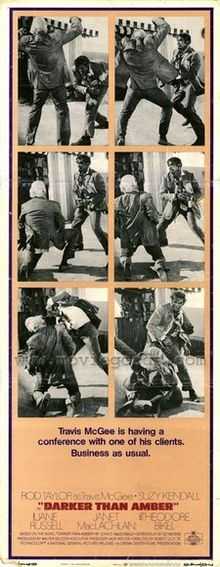Darker than Amber (film)
| Darker than Amber | |
|---|---|
 Original poster | |
| Directed by | Robert Clouse |
| Produced by |
Jack Reeves (executive producer) Walter Selzer (producer) |
| Written by |
John D. MacDonald Ed Waters |
| Starring | Rod Taylor |
| Music by | John Carl Parker |
| Cinematography | Frank V. Phillips |
| Edited by | Fred A. Chulack |
| Distributed by | National General Pictures |
Release dates | August 14 1970 |
Running time | 96 min |
| Country | U.S. |
| Language | English |
| Budget | $2,607,328[1] |
| Box office | $1,621,897[1] |
Darker than Amber is a 1970 film adaptation of the John D. MacDonald novel Darker than Amber. It was directed by Robert Clouse from a screenplay by MacDonald and Ed Waters. It starred Rod Taylor as Travis McGee. Darker than Amber and The Empty Copper Sea (adapted as the film Travis McGee (1983) starring Sam Elliott) remain the only McGee novels adapted to the big screen as of 2013. Prior to her death in 2011, with the exception of a documentary appearance in 2007, this film was the last one made by actress Jane Russell.
Plot summary
The film is faithful to the plot of the novel. McGee and his close friend Meyer are fishing underneath a bridge when a young woman (a former prostitute named Vangie) is thrown off the bridge, weighted with a cement block around her ankles. McGee dives in and saves her, and is surprised when she insists that he not contact the police. She admits that she was nearly killed due to her involvement in a prostitution ring and a murder scheme. The trio travels to Nassau to investigate her would-be murderers, who work in male/female pairs to lure rich, lonely men traveling on cruise ships into their confidence, rob them, and then toss them overboard to drown. McGee and Meyer set out to dismantle the operation.
Cast
- Rod Taylor as McGee
- Theodore Bikel as Meyer
- Suzy Kendall as Vangie
- Jane Russell as Alabama Tigress
- William Smith as Terry
Production
Other actors considered for the role of Travis McGee were Jack Lord and Robert Culp. John D. MacDonald pushed for Steve McQueen or Vic Morrow. The movie was shot on location in Florida and Nassau.[2]
Critical reception
Though it did not gross well in the box office, the film was praised by such critics as Roger Ebert as "a surprisingly good movie".[3] The New York Times also gave the film reserved praise, stating that the screenplay lagged in parts despite the good material to work from (in the original novel), and that the real star of the film was its Florida setting.[4]
It is a cult film, due to its scarcity, and to the fact it is almost never shown on broadcast or on cable TV, and when it is, the fight scene is edited to some extent. If and when a print can be located, there are almost always missing minutes. Though many cuts of this film exist, pristine American prints seem to have disappeared years ago.
The film played a rare theatrical screening at Anthology Film Archives in New York City, New York, on August 14, 2009.[5][6][7]
Box Office
The film recorded admissions of 17,351 in France.[8]
The film recorded a loss of $2,958,251. Producer Jack Reeves had bought the rights for another McGee novel The Deep Blue Goodbye but it was decided not to proceed with it.[1]
Fight scenes and rating
Initially rated R in the United States, it later became rated PG. the film was considered graphically violent for its time, especially the fist fight scene that ends the film, between Rod Taylor's Travis Mcgee and the film's villain, Terry (played by William Smith). With the cameras rolling one actor accidentally struck the other (no one has ever revealed who struck the first real blow), the second threw a retaliatory punch, and a staged fight scene became a real fight, with real wounds, real lost teeth, and real blood all over their clothing.
After Darker Than Amber ran its course in theaters, both Rod Taylor and William Smith would reportedly be considered for the part of Caucasian martial artist Roper in the 1973 Bruce Lee blockbuster Enter the Dragon, which would also be helmed by Darker Than Amber director Robert Clouse.[9][10] The role would ultimately go to John Saxon, however.[11]
Footnotes
- ↑ 1.0 1.1 1.2 Stephen Vagg, Rod Taylor: An Aussie in Hollywood (Bear Manor Media, 2010) p154
- ↑ Stephen Vagg, Rod Taylor: An Aussie in Hollywood, Bear Manor Media 2010 p152
- ↑ (Ebert 1971)
- ↑ (Thompson 1970)
- ↑ Rapold, Nicolas. "True grit: Anthology Film Archives and William Lustig unearth some lost gems of '70s Hollywood", Time Out New York, Issue 723 : Aug 6–12, 2009
- ↑ Anthology Film Archives schedule
- ↑ Cinema Strikes Back: "Anthology Film Archives Screens The Seventies – Buried Treasures Series, Curated by William Lustig"
- ↑ 1971 Box Office Figures in France at Box Office Story
- ↑ http://www.cityonfire.com/commentary/etd.mp3
- ↑ http://www.imdb.com/title/tt0070034/trivia?tr0646647
- ↑ http://www.imdb.com/title/tt0070034/
References
- Thompson, Howard (August 15, 1970). "Darker Than Amber (1970)". The New York Times.
- Ebert, Roger (January 12, 1971). "Darker Than Amber". Chicago Sun-Times.
External links
| ||||||